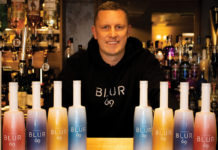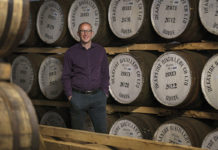David Wilkinson, head distiller at Edinburgh Gin talks to SLTN

Q: Where do you work?
A: We have two distilleries. Our first distillery opened in 2014 in the basement of the Rutland Hotel in Edinburgh’s west end. We have two 150L stills, Flora and Caledonia, which produce our seasonal gins. The distillery is open to the public and we run tours through the day. In the evening the space is converted into the Heads & Tales cocktail bar. Our second distillery opened in 2016 in a former biscuit factory in Leith. Our larger still, ‘Gin Jeanie’, produces four times as much gin per day as Flora and Caledonia combined. Our Classic Gin has been distilled there from the beginning and in 2018 we moved production of Seaside Gin there due to increased demand.
Q: How long have you worked on the brand and how did you start?
A: I joined the Edinburgh Gin team in 2014 when our first distillery opened. My first two and a half years was on a graduate scheme known as a Knowledge Transfer Partnership. I was employed by Heriot-Watt University (from where I graduated with MSc Brewing & Distilling) but spent most of my time working at the distillery.
Q: Describe the production process.
A: Our gin recipes use a combination of the two main distilling techniques for gin: maceration and vapour infusion. The majority of botanicals are macerated overnight in GNS (grain neutral spirit) reduced to 50-60% ABV. This softens the skins and dissolves the essential oils that will give the gin its flavour. For more delicate botanicals such as flowers and leaves we use the vapour infusion method: suspending the botanicals in the head of the still so the flavour is extracted more gently without stewing or burning the plants. Gin Jeanie has a special copper basket for this but as Flora is much smaller we use teabags filled with our more delicate botanicals. We use a wide variety of botanicals in our gins and try to get the balance right between having enough botanicals to give the gin a unique flavour but not so many that there’s so much going on there’s no definitive flavour. Of course the most important botanical is juniper. We use two different juniper crops: North Macedonian juniper in our Classic Gin, which is slightly sweeter; and Italian juniper in our Seaside and Cannonball (Navy Strength) gins, which has more pine and spicy notes.
Q: What’s a typical working day like?
A: It usually starts with cleaning; the stills have to be emptied and cleaned out from the previous day’s distillation before being filled with fresh neutral spirit and botanicals for that day’s batch. If there’s any sensory work to do that tends to come next; if we’re testing out a new recipe or doing quality control work it’s best to do it in the morning when our senses are at their most receptive and we can pick out subtle differences in flavour and aroma. The rest of the day can be varied: giving tours, hosting tastings, taking deliveries or catching up on paperwork.
Q: Please provide brief tasting notes for your product.
A: Edinburgh Gin is a classic London Dry with a Scottish twist. The main focus is juniper; we use juniper from North Macedonia for its oily mouthfeel and sweeter aftertaste. After juniper the predominant flavour is citrus. A combination of bitter orange peel, lime peel and lemongrass gives a refreshing citrus flavour to complement the juniper. Lavender adds a floral aroma and pine buds complement the pine aromas from the juniper. To add mouthfeel to the gin we add ground hazelnuts and the seeds of the milk thistle. Aroma and flavour contribution is minimal from these two botanicals but their thicker essential oils add smoothness and viscosity to the gin. Finally we have black mulberries to add a soft fruity aftertaste which balances the citrus.
Q: What would you say sets your product apart?
A: The Edinburgh Gin range is one of the most diverse in the world of gin. As well as our Classic Gin we have Navy Strength, seasonal London Dry gins, fruit flavoured gins and gin-based liqueurs. With so much variety across the range we’re confident we have a gin for everybody. What also sets us apart is our dedication to producing the best quality liquids possible. This starts with the raw materials (ie. botanicals). We have a rigorous process for sourcing the best botanicals, especially juniper. We take samples from several different juniper suppliers and distill small quantities on our mini still. The samples are then blind tested for aroma, flavour and mouthfeel by the distilling team with the sample that ranks the highest being the juniper we use for our gins. We have even gone to the detail of using different juniper for certain gins as we felt the flavour profile worked better when combined with certain other botanicals. Our product development process is equally thorough, with multiple miniature distillations being done to get the recipe exactly right before scaling up.
Q: What one fact should bartenders know about your brand?
A: We aim to have a distinct but balanced flavour in our gins. Each botanical is there for a reason, be it aroma, flavour, mouthfeel or aftertaste. The best way to enjoy our gin is to serve it in a way that accentuates the flavour already there rather than trying to overcomplicate it with too many other flavours.
Q: What’s your favourite part of the job?
A: Gin is all about botanicals so working with quality botanicals is a passion of mine. It’s very satisfying to work with something locally sourced or hand-foraged, that gives a real personal connection with the gin you’re distilling. Working with a new or unique botanical is very exciting too; creating a gin recipe using a botanical that hasn’t been used in gin before will make you really stand out.
Q: What’s your favourite way to drink your brand?
A: Most importantly, when I drink gin I want to actually taste the gin – which is reflected in the ratios I use. I like a classic serve for our Classic Gin: a good old G&T (not too much tonic, 2:1 ratio is good) with an orange peel garnish to bring out the citrus flavours. For our Navy Strength gin I like a dry Martini (and I do mean dry, 10:1) with a twist of lemon. Even for a Negroni I deviate from the traditional 1:1:1 ratio. For me it’s 1.5 gin:1 vermouth:0.5 Campari, it’s all about the gin!
Q: What’s your career highlight so far?
A: A big moment was when Cannonball won IWSC Gold in 2015. I had been with Edinburgh Gin a year at that point and it was an important indicator that we were doing a good job and producing quality gin. However my ultimate highlight would have to be being named Distiller of the Year at the 2019 Icons of Gin Awards. That was an amazing honour and not something I thought I had a chance of receiving until I’d been in the industry for several more years.
Q: Who do you admire in the industry and why?
A: I admire all of the distillers who made their way into the industry through Heriot-Watt University, as I did. Heriot-Watt runs an outstanding Brewing & Distilling course with people from all sorts of career paths that have taken an interest in the drinks industry.
Q: How do you relax outside of work?
A: Running, baking cakes and enjoying some of the great spirits outside of gin – for example, I’m a big whisky fan.




















